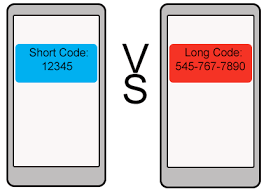Most people who use text messaging as a regular method of communication, probably don’t think too much about the history and science behind sending a text or an SMS (short message service) message.
6 billion text messages sent each day, Cellular Telecommunications Industry Association (CTIA) stats show. We’ve come a long way from the average 0.4 messages sent each month by mobile customers back in the 90s.
History of the Short Code:
Short codes were originally created as one of the first high-level languages for a computer in 1949 – first known as “brief code,” according to a book called the “History of Programming Languages” by Richard L. Wexelblat. Short codes evolved over the decades for mobile communication use. The first SMS message was sent December 1992. In the early 2000s, short codes became a way for companies to communicate with customers via SMS. The idea provided a five or six digit number that was hopefully easy to remember. Wireless carriers in the United States offered premium SMS charged directly on your wireless bill to send and receive messages. In 10-15 years, short code use boomed. Businesses and organizations send text messages to customers daily.
Difference between a Short Code vs. Long Code:
Short codes range in size from four to nine digits, with the most commonly used being 4, 5 and 6 digits.
Most people are familiar with long codes. 10-digit numbers used to send and receive SMS messages, and phone calls. While long codes can be used, short codes are much more effective for bulk texting. Long codes take longer to send and cannot send to as many recipients as short codes. Short code texting, the only carrier approved method for sending bulk text messages. However, a big difference between long code and short code is that a message coming from a long code might seem more personal because it looks like it is coming from a regular telephone number.
The biggest, and most obvious difference between a short code vs. long code is the number of digits. A short code is shorter and easier to remember. For marketing, short codes are best for getting your customers to opt-in to receive text messages for promotions, deals, information, events and more.
Sometimes a long code can be effective for:
- Communicating one-on-one with customers
- Providing customer service
- An Internet texting network with staff
Short Codes Uses:
For example, a furniture business might have a sale for Labor Day – one of the biggest furniture sale days of the year. To reach customers, a business might place an ad in the local paper and have commercials on TV and the radio. But in a world where the large portion of the population is looking at a phone screen far more than their TV or listening to the radio, it only makes sense to use marketing where customers will see it. That is where the short code comes into play – with text message marketing.
Keep in mind, to send text messages to customers, the business must have a list of customer cell phone numbers who have opted-in (consented) to receive text messages. Usually, a business will advertise a call-to-action to invite new/existing customers to send a text to opt-in.
To explain, an online social media or other business ad might say, “For an extra 5 percent off on our 20 percent off Labor Day Sale, text the word COUCH to 21000”. Send the text, get an extra 5% off.
In the above exampled, the short code is 21000. From this code, the business can then communicate with its customers. Many text marketing companies offer two-way communication services in addition to bulk text messaging services.
Ultimately, the text needs determine if a short code, long code or both is used to send business texts.
